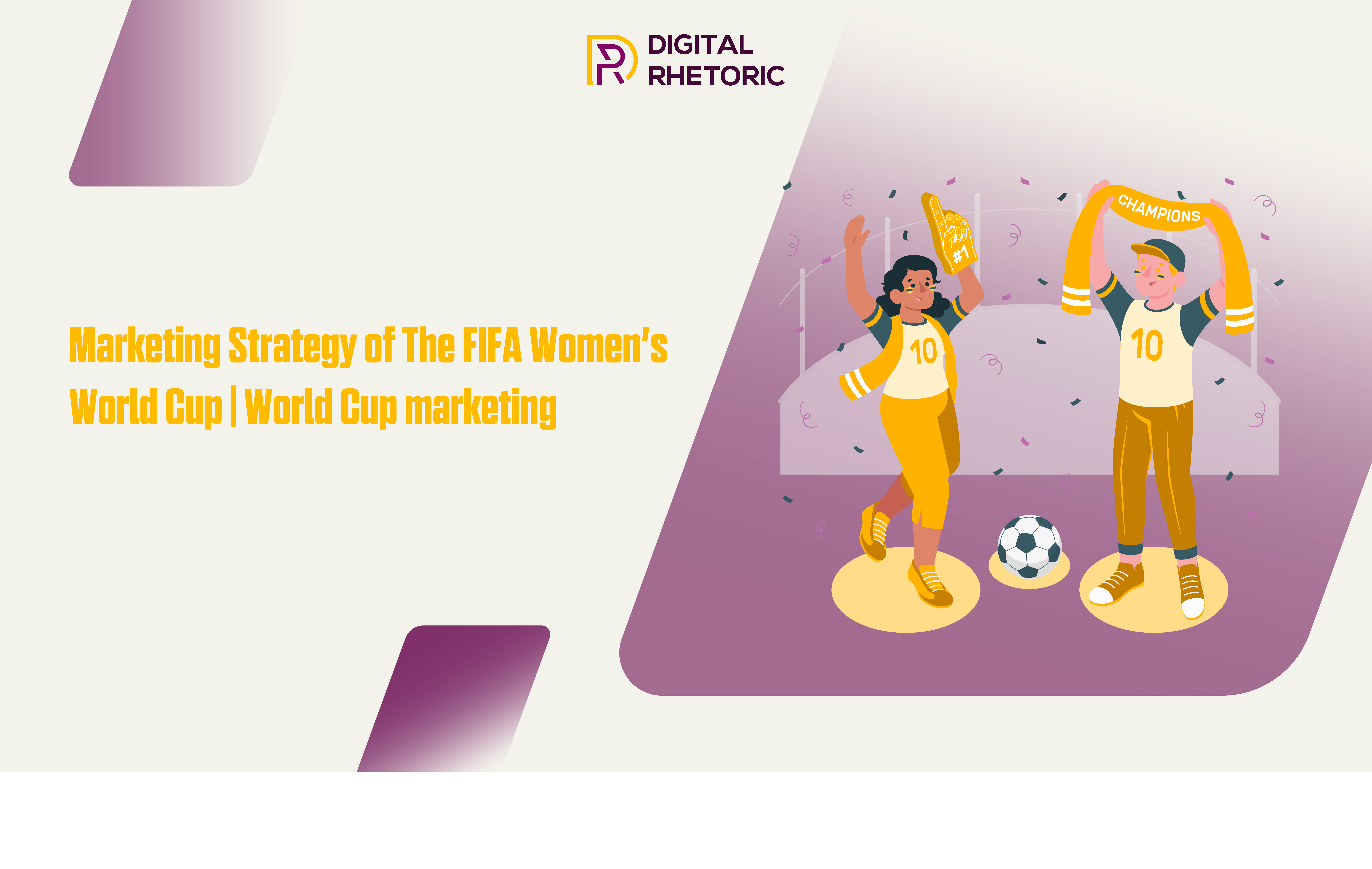Marketing Strategy of The FIFA Women’s World Cup | World Cup marketing
- Meenal Ghai
- November 10, 2023
- Blog
- Digital Marketing, Digital Marketing Agency, Digital Marketing Company, Digital Marketing Services, PPC Marketing Services, SEO Services, Social Media Marketing
- 0 Comments

The FIFA Women’s World Cup stands as a pinnacle in women’s sports, showcasing the prowess and talent of top female footballers on the global stage. This premier international tournament has gained immense significance in recent years, transcending boundaries and redefining the landscape of women’s athletics. The evolution of World Cup marketing strategies has played a crucial role in elevating the tournament’s profile, contributing to increased viewership and fostering a growing fanbase. As the world eagerly anticipates each edition, the marketing endeavors surrounding the Women’s World Cup continue to make meaningful strides in promoting gender equality and empowering women in sports.
Evolution of Women’s World Cup Marketing
- Inaugural Tournament (1991):
- Introduction of the first Women’s World Cup marked a historic moment in women’s football.
- Limited marketing efforts focused on establishing the tournament’s identity.
- USA 1999: Breakthrough Marketing:
- The 1999 World Cup in the USA witnessed a paradigm shift in marketing.
- Iconic campaigns like “99ers” elevated the tournament’s visibility.
- Increased media coverage and strategic partnerships.
- Germany 2011: Global Expansion:
- Expanded global outreach with enhanced marketing strategies.
- Focus on international collaborations and increased sponsorships.
- Canada 2015: Digital Transformation:
- Embracing digital platforms for marketing, leveraging social media.
- Enhanced fan engagement through interactive campaigns.
- France 2019: Commercial Success:
- Record-breaking viewership and commercial success.
- Strong emphasis on diversity and inclusivity in marketing campaigns.
- Ongoing Efforts (2023 and Beyond):
- Continued growth with innovative marketing strategies.
- Increased investment, sponsorships, and collaborative initiatives.
Target Audience Analysis
The target audience for the FIFA Women’s World Cup marketing campaigns has evolved dynamically, reflecting a broader and more diverse demographic. Initially, marketing efforts primarily targeted football enthusiasts and existing fans of the sport, with a focus on building credibility for women’s football. Over the years, there has been a strategic shift towards inclusivity, aiming to capture the attention of a wider audience. The marketing strategy now actively engages not only football aficionados but also emphasizes reaching out to families, young girls aspiring to play football, and a global audience passionate about women’s sports. This evolution aligns with the overarching goal of promoting gender equality and empowering women in sports, broadening the appeal of the Women’s World Cup beyond traditional football enthusiasts to become a global celebration of athletic excellence and inclusiveness.
Innovative Campaigns and Partnerships
- Nike’s “Dream Further” (2019):
- Nike’s captivating campaign featured young girls imagining themselves as their football idols.
- It emphasized the aspirational nature of women’s football, resonating with a diverse audience.
- Adidas’ “Creating Change” (2019):
- Adidas focused on empowerment, featuring players advocating for change and equality.
- A powerful narrative aligned with the growing global conversation on gender equality.
- #DareToShine Campaign (2019):
- FIFA’s campaign highlighted the theme “Dare to Shine,” encouraging women to pursue their dreams.
- Collaborated with various influencers and athletes to amplify the message.
- Mastercard Partnership (2019):
- Mastercard’s sponsorship and campaign emphasized the priceless moments in women’s football.
- Engaged fans with exclusive experiences and promotions during the tournament.
- Budweiser’s “Queen of the Match” (2019):
- Budweiser celebrated the “Queen of the Match” in each game, honoring standout performances.
- The campaign aimed to recognize and uplift female athletes on a global stage.
These campaigns and partnerships not only elevated the Women’s World Cup brand but also contributed significantly to the broader conversation on gender equality and women’s empowerment in sports.
Social Media Impact
Social media plays a pivotal role in amplifying the excitement and engagement surrounding the FIFA Women’s World Cup, fostering a global community of fans and supporters.
- Hashtag Campaigns:
- #FIFAWWC:
- The official hashtag creates a unified space for fans to follow and contribute to the conversation.
- Enables real-time tracking of discussions and trending topics related to the Women’s World Cup.
- Fan Interaction and User-Generated Content:
- Social media platforms provide a direct channel for fans to interact with teams, players, and each other.
- User-generated content, such as photos, videos, and personal anecdotes, adds a personal touch to the global narrative.
- Live Updates and Behind-the-Scenes:
- Teams and players leverage platforms like Instagram and Twitter to share live updates, behind-the-scenes glimpses, and exclusive content.
- Instantaneous engagement with fans creates a sense of immediacy and inclusivity.
- Global Reach and Diversity:
- Social media transcends geographical boundaries, allowing fans from all corners of the world to participate.
- Diverse content reflects the inclusive nature of women’s football, celebrating cultures and perspectives.
- Influencer Collaborations:
- Influencers and football personalities collaborate to reach wider audiences and bring unique perspectives.
- Collaborative efforts generate buzz and broaden the conversation beyond traditional sports enthusiasts.
The dynamic synergy between social media and the Women’s World Cup not only serves as a platform for information dissemination but also cultivates a vibrant, interactive global community passionate about women’s football.
Diversity and Inclusivity in Marketing
Diversity, inclusivity, and gender equality take center stage in marketing campaigns for the FIFA Women’s World Cup, reflecting a commitment to breaking barriers and fostering a more equitable sports landscape.
- Equality Campaigns:
- Inclusive marketing campaigns emphasize the equal prowess, dedication, and athleticism of women in football.
- Representation Initiatives:
- Promotional materials showcase diverse backgrounds, ethnicities, and cultures, promoting a more inclusive image of women’s football.
- Empowerment Narratives:
- Campaigns highlight empowering stories, emphasizing resilience, leadership, and the impact of women in football beyond the pitch.
These initiatives not only celebrate the athleticism of women but also contribute to reshaping societal perceptions and promoting a more inclusive and diverse sporting world.
Impact on Women’s Sports and Empowerment
| MARKETING STRATEGY | CONTRIBUTION TO EMPOWERING WOMEN IN SPORTS |
| Inclusive representation | Showcasing diverse athletes breaks stereotypes, inspiring women to pursue football and sports careers. |
| Empowering Narratives | Highlighting stories of resilience and achievement fosters a culture of empowerment and encourages women to overcome challenges. |
| Equal Exposure | Providing equal media coverage and promotional opportunities reinforces the idea that women’s sports deserve the same attention and recognition as men’s sports. |
| Community Engagement | Involving fans globally fosters a sense of community, uniting individuals in their support for women in sports. |
| Athlete-Centric Campaigns | Placing athletes at the forefront humanizes the sport, showing the determination and skill of women in football. |
| Inclusivity Initiatives | Implementing programs that encourage inclusivity in football participation promotes a welcoming environment for women of all backgrounds. |
The marketing strategies employed by the Women’s World Cup not only promote the tournament but also play a crucial role in advancing the broader goals of empowering women in sports.
Challenges and Controversies
Navigating Challenges in Women’s World Cup Marketing:
The marketing landscape for the FIFA Women’s World Cup has not been without challenges, reflecting broader societal perceptions and historical disparities in sports.
- Unequal Funding: Historically, the Women’s World Cup faced disparities in funding compared to its male counterpart, impacting promotional efforts. Marketing strategies now emphasize the need for equitable investment and resource allocation.
- Media Bias: Overcoming media bias and securing equal broadcasting rights has been a hurdle. Marketing initiatives actively address this by amplifying the tournament’s visibility and advocating for fair media representation.
- Societal Perception: Deep-rooted gender stereotypes in sports have posed challenges. Marketing campaigns confront these stereotypes head-on, challenging outdated perceptions and portraying women’s football as equally captivating and competitive.
- Sponsorship Disparities: Securing sponsorships has been an uphill battle. However, strategic partnerships and campaigns emphasizing the positive impact of supporting women’s sports have attracted sponsors and narrowed the sponsorship gap.
By acknowledging and addressing these challenges, Women’s World Cup marketing has evolved to champion equality, challenge stereotypes, and promote women’s football as a force to be reckoned with.
Fan Engagement and Merchandising
Strategies to Engage Fans and Boost Visibility:
- Interactive Social Media Campaigns:
- Engage fans through interactive social media campaigns, quizzes, and challenges.
- Create unique hashtags to foster a sense of community and encourage user-generated content.
- Fan-Centric Events and Initiatives:
- Organize fan-centric events, such as meet-and-greets, autograph sessions, and virtual Q&A sessions with players.
- Launch initiatives that allow fans to actively participate, such as voting for their favorite moments or players.
- Exclusive Merchandise and Limited Editions:
- Introduce exclusive Women’s World Cup merchandise, including jerseys, scarves, and collectibles.
- Offer limited-edition items to create a sense of urgency and exclusivity, driving fan enthusiasm.
- Virtual Fan Zones:
- Create virtual fan zones with interactive elements like live chats, virtual cheering, and digital fan walls.
- Facilitate global participation, bringing fans together irrespective of geographical boundaries.
- Fantasy Leagues and Prediction Contests:
- Launch fantasy leagues and prediction contests to engage fans in a competitive and entertaining manner.
- Offer prizes and incentives to enhance participation and excitement.
- Augmented Reality (AR) Experiences:
- Implement AR experiences, allowing fans to virtually try on team jerseys or access augmented reality filters related to the tournament.
- Enhance the overall fan experience by leveraging cutting-edge technology.
Role of Merchandise in Boosting Visibility:
Merchandise plays a pivotal role in enhancing the Women’s World Cup’s visibility:
- Walking Advertisements:
- Fans become walking advertisements, showcasing team colors and logos through purchased merchandise.
- Brand Recognition:
- Branded merchandise enhances brand recognition, both for the tournament and the participating teams.
- Revenue Generation:
- Merchandise sales contribute to revenue generation, supporting the sustainability and growth of women’s football.
- Cultural Impact:
- Iconic merchandise items become cultural symbols, fostering a sense of identity and pride among fans.
- Global Outreach:
- Merchandise acts as a global ambassador, reaching fans worldwide and promoting the Women’s World Cup on an international scale.
By combining engaging fan strategies with enticing merchandise offerings, the tournament can significantly boost its visibility and create a lasting impact on fans worldwide.
Future Trends in Women’s World Cup Marketing
- Digital Immersion and Virtual Reality:
- Embrace advanced digital technologies like virtual reality (VR) to provide immersive fan experiences.
- Create virtual stadiums, allowing fans to virtually attend matches and engage in interactive experiences.
- Personalized Fan Engagement:
- Utilize data analytics to understand fan preferences and behaviors for personalized marketing campaigns.
- Tailor content, offers, and interactive experiences based on individual fan profiles.
- Inclusive and Diverse Representation:
- Continue promoting inclusivity and diversity in marketing campaigns, showcasing the global reach and diverse fanbase of women’s football.
- Collaborate with influencers and ambassadors who represent different cultures and backgrounds.
- Augmented Reality (AR) Fan Engagement:
- Expand the use of augmented reality for real-time interactive experiences during matches.
- Implement AR features in marketing materials, enhancing engagement and creating shareable content.
- Sustainability and Eco-Friendly Initiatives:
- Incorporate sustainability into marketing strategies, promoting eco-friendly initiatives and responsible consumption.
- Develop merchandise and promotional materials with a focus on sustainable and recyclable materials.
- Interactive Social Media Experiences:
- Evolve social media strategies to include more interactive experiences, such as live polls, 360-degree videos, and augmented reality filters.
- Encourage user-generated content and fan testimonials to enhance authenticity.
- E-Sports Integration:
- Explore partnerships with e-sports platforms to engage a broader audience.
- Organize women’s football e-sports tournaments and integrate gaming elements into marketing campaigns.
- Blockchain for Fan Authentication:
- Implement blockchain technology to enhance fan authentication, ticketing, and merchandise authentication.
- Ensure the security and authenticity of limited-edition items through blockchain verification.
- Localized and Language-Specific Content:
- Develop marketing content in multiple languages to cater to diverse global audiences.
- Localize campaigns by incorporating region-specific cultural references and nuances.
- Storytelling through Emerging Platforms:
- Utilize emerging platforms, such as TikTok and Clubhouse, for innovative storytelling and engaging content.
- Experiment with new formats and mediums to capture the attention of younger and tech-savvy audiences.
By staying at the forefront of technological advancements and understanding the evolving preferences of the fanbase, the FIFA Women’s World Cup can continue to revolutionize its marketing strategies, ensuring sustained growth and global appeal.
Case Studies of Successful Women’s World Cup Marketing Campaigns:
- Nike’s “Dream Further” (2019):
- Objective: Nike aimed to inspire and empower the next generation of female footballers.
- Key Takeaways:
- Emotional Storytelling: The campaign featured an animated film portraying a young girl’s journey and dreams in football, connecting emotionally with the audience.
- Inclusivity: Highlighted the importance of breaking barriers and challenging stereotypes, promoting inclusivity in women’s football.
- Global Reach: Leveraged the global appeal of football, resonating with audiences worldwide.
- FIFA’s “Dare to Shine” (2019):
- Objective: FIFA sought to promote women’s football and encourage more girls to participate.
- Key Takeaways:
- Youth Engagement: Emphasized engaging with young girls by promoting football as a sport for everyone.
- Digital Activation: Leveraged social media challenges and interactive content, encouraging fans to share their football stories.
- Partnerships: Collaborated with influencers and football personalities to amplify the campaign’s reach.
- Visa’s “One Moment Can Change the Game” (2019):
- Objective: Visa aimed to celebrate the impact of women in football and inspire positive change.
- Key Takeaways:
- Branding Integration: Incorporated the campaign seamlessly into Visa’s overall brand messaging, aligning with their commitment to diversity and inclusion.
- Fan Engagement: Encouraged fans to share their favorite moments in women’s football, fostering a sense of community.
- Global Visibility: Leveraged the widespread reach of the FIFA Women’s World Cup to gain international visibility.
- Adidas’ “When I Play” (2015):
- Objective: Adidas focused on empowering female athletes and changing perceptions about women’s sports.
- Key Takeaways:
- Athlete-Centric Approach: Featured elite female footballers sharing their personal stories, promoting authenticity.
- Social Media Amplification: Leveraged social media platforms to engage with a younger demographic, creating shareable content.
- Product Integration: Seamlessly integrated Adidas products into the campaign, driving brand association with women’s football.
- UEFA’s Together #WePlayStrong (Ongoing):
- Objective: UEFA’s campaign aims to boost the image of women’s football and increase participation.
- Key Takeaways:
- Digital Content Hub: Created a centralized digital platform for women’s football content, fostering a sense of community.
- Youth Focus: Targeted young audiences through engaging and relatable content, including player features and skill tutorials.
- Collaboration: Collaborated with influencers, football clubs, and national associations to amplify the campaign’s impact.
These case studies illustrate the diverse approaches taken by brands and organizations to promote women’s football successfully. Common themes include emotional storytelling, inclusivity, digital activation, and leveraging partnerships for global visibility.
Conclusion
The marketing strategies deployed in the FIFA Women’s World Cup have not only heightened the tournament’s global profile but have become catalysts for transformative change in women’s sports. These initiatives, grounded in inclusivity and authenticity, have empowered female athletes and challenged stereotypes, shaping a more equitable future. As the tournament continues to inspire and uplift, the impact of strategic marketing extends beyond the pitch, paving the way for a brighter future in women’s sports. Explore the evolution of women’s sports marketing at https://digitalrhetoric.in/. Dare to dream, dare to play – together, let’s redefine the game!

